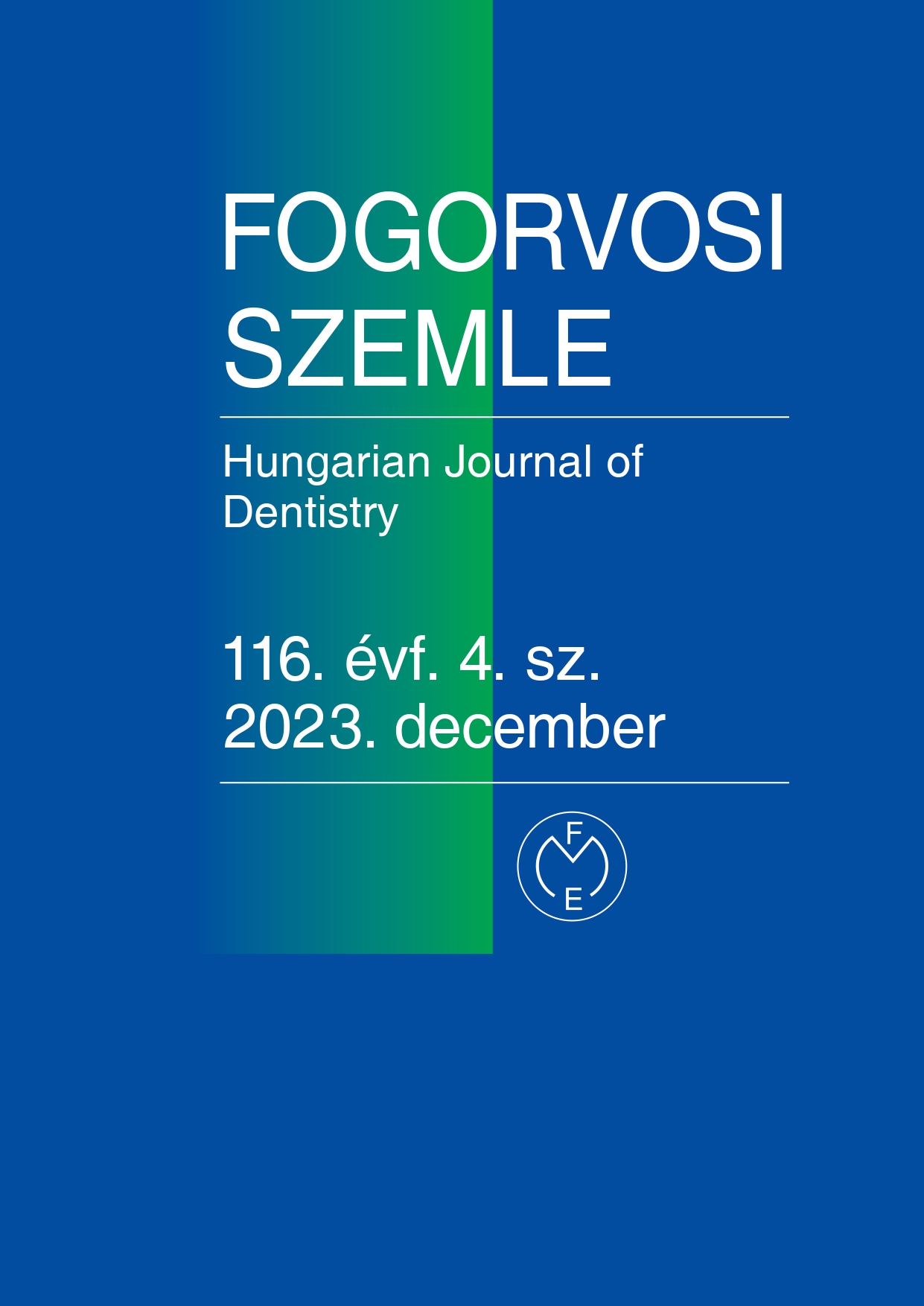Complex treatment of a soft tissue defect adjacent to an implant osseointegrated in malposition
Abstract
The purpose of this case presentation is to illustrate the conservative, surgical and prosthetic rehabilitation of soft tissue
defects caused by malpositioned implants, and to provide a treatment option in the case of aesthetically unfavorable
changes around healed implants. The patient came to our office with previously placed and healed implants with the
screwed healing abutments in positions of the maxillary right and left lateral incisors and the maxillary right second premolar.
Furthermore temporary restorations were put on the maxillary central incisors, canines, premolars and right first
molar. Her main complaint was the severe soft tissue dehiscence next to the two front implants, which made her smile
aesthetically unacceptable, caused by the angulation and depth differences of the implants. Explantation and insertion of a
new implants could presumably have resulted in large osseous defects, due to the aggravating effect of the completely
osseointegrated implants and the limited volume of the buccal bone. Our treatment plan included the reduction of prosthetic
abutments and surgical soft tissue management. After the healing period, the patient received definitive prosthodontic
care. By the end of the treatment series, our patient was satisfied with both the pink and white aesthetics.
References
Angelopoulos C, Aghaloo T: Imaging technology in implant diagnosis. Dental clinics of North America 2011; 55 (1): 141–158. https://doi.org/10.1016/j.cden.2010.08.001
Berglundh T, Lindhe J: Dimension of the periimplant mucosa: Biological width revisited. Journal of Clinical Periodontology 1996; 23 (10): 971–973. https://doi.org/10.1111/j.1600-051X.1996.tb00520.x
Canullo L, Pesce P, Patini R, Antonacci D, Tommasato G: What Are the Effects of Different Abutment Morphologies on Peri-implant Hard and Soft Tissue Behavior? A Systematic Review and Meta-Analysis.The International journal of prosthodontics 2020; 33 (3): 297–306. https://doi.org/10.11607/ijp.6577
Dellavia C, Ricci G, Pettinari L, Allievi C, Grizzi F, Gagliano N: Human palatal and tuberosity mucosa as donor sites for ridge augmentation. The International journal of periodontics & restorative dentistry 2014; 34 (2): 179–186. https://doi.org/10.11607/prd.1929
Elani HW, Starr JR, Da Silva JD, Gallucci GO: Trends in Dental Implant Use in the U.S., 1999–2016, and Projections to 2026. Journal of dental research 2018; 97 (13): 1424–1430. https://doi.org/10.1177/0022034518792567
Gamborena I, Avila-Ortiz G: Peri-implant marginal mucosa defects: Classification and clinical management. Journal of periodontology 2021; 92 (7): 947–957. https://doi.org/10.1002/JPER.20-0519
Gomez-Meda R, Esquivel J, Blatz MB: The esthetic biological contour concept for implant restoration emergence profile design. Journal of esthetic and restorative dentistry: official publication of the American Academy of Esthetic Dentistry [et al] 2021; 33 (1): 173–184. https://doi.org/10.1111/jerd.12714
Joób-Fancsaly A, Divinyi T, Fazekas A, Petó G, Karacs A: Fogászati implantátumok felületkezelése nagy teljesítményű lézersugárral [Surface treatment of dental implants with high-energy laser beam]. Fogorvosi Szemle 2000; 93: 169–180.
Joób-Fancsaly Á, Karacs A, Pető G, Körmöczi K, Bogdán S, Huszár T: Effects of a Nano-structured Surface Layer on Titanium Implants for Osteoblast Proliferation Activity. Acta Polytechnica Hungarica 2016; 13: 7–25.
Raetzke PB: Covering localized areas of root exposure employing the “envelope” technique. Journal of periodontology 1985; 56 (7): 397–402. https://doi.org/10.1902/jop.1985.56.7.397
Roy M, Loutan L, Garavaglia G, Hashim D: Removal of osseointegrated dental implants: a systematic review of explantation techniques. Clinical oral investigations 2020; 24 (1): 47–60. https://doi.org/10.1007/s00784-019-03127-0
Su H, Gonzalez-Martin O, Weisgold A, Lee E: Considerations of implant abutment and crown contour: critical contour and subcritical contour. The International journal of periodontics & restorative dentistry 2010; 30 (4): 335–343.
Vadócz R CZ, Nagy K, Kivovics P: Guided Biofilm Therapy. Magyar Fogorvos 2016; 5: 238–241.
Wan W, Zhong H, Wang J: Creeping attachment: A literature review. Journal of esthetic and restorative dentistry: official publication of the American Academy of Esthetic Dentistry [et al] 2020; 32 (8): 776–782. https://doi.org/10.1111/jerd.12648
www.nobelbiocare.com/en-int/galvosurge-implant-cleaningsystem-user-page (2023.06.22.)
Zucchelli G, Mazzotti C, Mounssif I, Mele M, Stefanini M, Montebugnoli L: A novel surgical-prosthetic approach for soft tissue dehiscence coverage around single implant. Clinical oral implants research 2013; 24 (9): 957–962. https://doi.org/10.1111/clr.12003
Zuhr O, Bäumer D, Hürzeler M: The addition of soft tissue replacement grafts in plastic periodontal and implant surgery: critical elements in design and execution. Journal of Clinical Periodontology 2014; 41 Suppl 15: S123–142. https://doi.org/10.1111/jcpe.12185
Copyright (c) 2023 Authors

This work is licensed under a Creative Commons Attribution 4.0 International License.


.png)




1.png)



